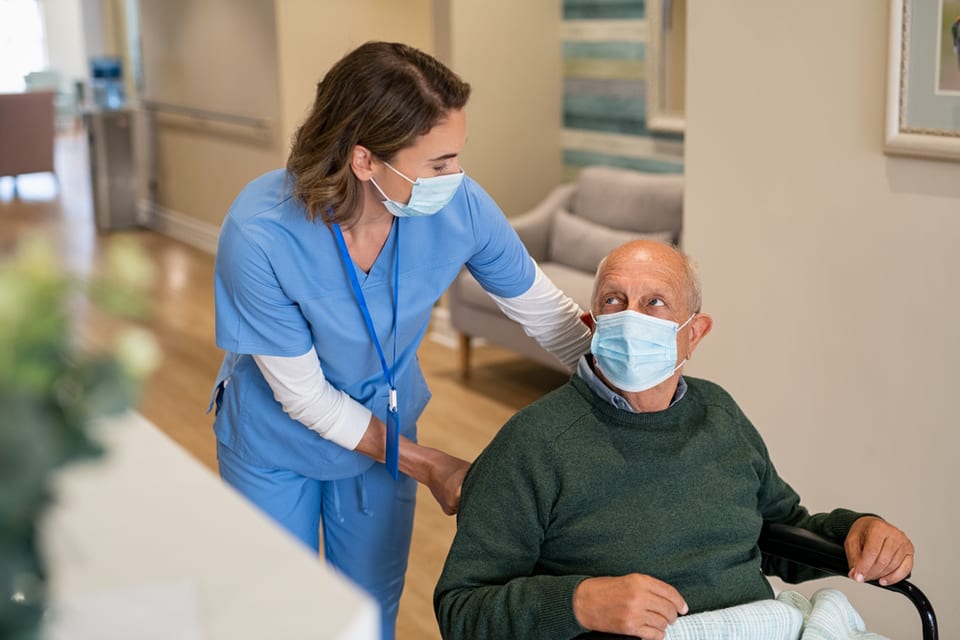
Senior Living and Mobility: Assistance, Safety, and Wellness

If your senior loved one has trouble getting around on their own or needs help with mobility-related tasks, it’s paramount that they have access to the proper assistance in an environment that fits their needs.
Let our care assessment guide you
Our free tool provides options, advice, and next steps based on your unique situation.
In the absence of proper help or safety features, seniors can become confined to their homes without safe access to items they need or a way to get them. These issues can lead to a whole host of concerns, including social isolation and a heightened risk of falling, which is the leading cause of injury for people 65 and older, according to the Centers for Disease Control and Prevention.
Many family caregivers modify homes to enable their senior loved ones to age in place. Though some in-home mobility safety features can be easy to install, others can become difficult, expensive, and time-consuming to complete.
Things like stair and toilet lifts can increase a home’s accessibility, but if a wheelchair user can’t transfer out of the wheelchair to the equipment and back on their own, they’ll still need additional assistance. Ill-performed transfers can lead to serious injuries in both the senior and the caregiver.
If you’re worried that these mobility-related concerns might become an issue down the road, senior living may be more appropriate than aging in place. Read on to learn what safety features you should expect to find in communities, how different types of senior living facilities provide mobility assistance, and how senior living promotes good mobility and active lifestyles.
Mobility safety features in senior living
Senior living facilities will typically have a variety of built-in mobility features to meet accessibility needs and safety concerns.
Some common mobility features in senior living facilities include:
- Wide hallways and doors
- Grab bars and handrails
- Walk-in and roll-in showers
- Flattened thresholds
- Ramps
- Elevators
Senior living mobility assistance across care types
When you’re choosing what type of care will fit a senior’s needs, the important thing to consider is how much mobility assistance they’ll require. Some mobility device users can get around entirely on their own and can independently complete activities of daily living (ADLs), like bathing, dressing, and toileting. Other seniors need extensive help with ADLs and transfers, whether they use mobility devices for ambulation or not.
Read on to learn how different types of senior living communities assist with mobility.

Let our care assessment guide you
Our free tool provides options, advice, and next steps based on your unique situation.
Independent living
Independent living is suitable for seniors that can perform ADLs and transfer between surfaces without assistance. Though mobility assistance in independent living is more limited than in other types of senior living, these communities may provide wheelchair- and mobility-friendly spaces. So mobility device users can still enjoy the benefits of independent living if it fits their needs.
Assisted living
Assisted living is an appropriate option for seniors who need help with ADLs or with infrequent transfers, as long as they can bear some of their own weight during the transfer process. Since some facilities offer a continuum of care, mobility assistance in assisted living can vary. Independent seniors with mobility needs that are expected to increase in the near future may benefit from an assisted living community with a continuum of care.
Caregivers at these facilities are trained to perform safe transfers and to give personalized assistance with ADLs based on the senior’s abilities. If a senior needs extra mobility assistance, some communities coordinate with home care agencies to give proper support inside residents’ suites.
Memory care
Memory care facilities offer similar mobility assistance as assisted living, but they often take extra precautions to prevent unsafe wandering. These precautions often include intentional design features for dementia patients that reduce confusion and add safety, like color-coded walls, clearly labeled spaces, and secured enclosed courtyards.
Nursing homes
If a senior requires around-the-clock attention, needs help for most tasks, and can no longer bear their own weight during transfers, then a nursing home is likely the ideal care setting for them. Since many patients in these settings need extensive mobility assistance, nursing homes often utilize a variety of power or mechanical lifts to minimize fall risk, prevent caregiver injuries, and improve patients’ comfort.
How senior living promotes good mobility
Declining mobility is a common feature of normal aging — but it doesn’t have to be a life-changing obstacle. There’s actually a lot that senior living can offer to help residents manage or even improve mobility in some cases.
While the following measures can work for seniors aging in place, results may be easier to achieve in a senior living facility, where experienced staff members can help with each task.
Exercises
A community’s on-site fitness center can present a range of opportunities for senior residents to increase their strength and balance, which can help manage declining mobility or even lead to improvements. Some communities host different exercise classes to fit a range of fitness levels. Chair-based exercise classes are a commonly featured activity that can be approachable for many residents, including wheelchair users.
Balance-based exercises and walking sessions are also commonly featured in communities’ exercise programs, which can create other approachable outlets for seniors with varying mobility to stay active.
Stretches
Stretches are a staple of many senior communities’ exercise and wellness programs, and stretching can increase a senior’s range of motion, according to a study from the National Institutes of Health. There’s conflicting information about how long to hold stretches, how many repetitions you should do, and what kinds of stretches are the best, so consult a doctor or physical therapist to see if a stretching routine fits your or your loved one’s needs.

Talk with a Senior Living Advisor
Our advisors help 300,000 families each year find the right senior care for their loved ones.
Physical therapy
Some senior living communities offer on-site therapies that can be delivered in residents’ homes. Though physical therapy is offered more commonly, podiatrist services are also available in some communities, which can be beneficial for seniors with ankle or foot problems specifically.
Nutrition
Senior living communities can create chef-prepared, dietitian-approved menus that focus on senior health, and they can bring years of experience for addressing issues like age-related appetite loss and dehydration in seniors. Some communities even offer personalized meal plans to address a variety of chronic health conditions.
Good nutrition, which includes proper hydration and a healthy diet, helps seniors with the following:
- Mobility
- Activity and energy
- Maintenance of a healthy weight
- Manage pre-existing conditions
Some distinct mobility benefits of a proper diet can include the following:
- Stronger bones
- Healthier joints
- A more active brain
- Improved circulation
- An increased range of motion from fat loss
- Increased muscle strength and endurance
For a more in-depth look at mobility assistance in senior living communities, consider reaching out to one of the Senior Living Advisors at A Place for Mom to learn more about local options available to your loved one.
Sources:
Harvard Health Publishing. (2018, January 17). Is your diet sabotaging your mobility?
Occupational Safety and Health Administration. Safe patient handling.
Seecharan, S., Genese, J., Arana, C., Liggett, A., Kulsum, N., & Ahmad, R. (2019, March 1). Fall risk associated with mechanical lifts in nursing homes. Journal of the American Medical Directors Association. https://doi.org/10.1016/j.jamda.2019.01.101.
Stathokostas, L., Little, R. M. D., Vandervoort., A. A., & Paterson, D. H. (2012, November 8). Flexibility training and functional ability in older adults: A systematic review. Journal of Aging Research. https://doi.org/10.1155/2012/306818.
Mobility safety features in senior living
Senior living options in all states
The information contained on this page is for informational purposes only and is not intended to constitute medical, legal or financial advice or create a professional relationship between A Place for Mom and the reader. Always seek the advice of your health care provider, attorney or financial advisor with respect to any particular matter, and do not act or refrain from acting on the basis of anything you have read on this site. Links to third-party websites are only for the convenience of the reader; A Place for Mom does not endorse the contents of the third-party sites.
Make the best senior care decision
Make the best senior care decision